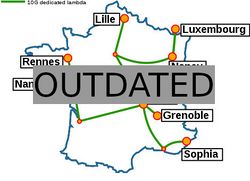Grid5000:Home: Difference between revisions
No edit summary |
No edit summary |
||
| Line 7: | Line 7: | ||
Key features: | Key features: | ||
* provides '''access to a large amount of resources''': 12000 cores, 800 compute-nodes grouped in homogeneous clusters, and featuring various technologies: GPU, SSD, NVMe, 10G Ethernet, Infiniband, | * provides '''access to a large amount of resources''': 12000 cores, 800 compute-nodes grouped in homogeneous clusters, and featuring various technologies: GPU, SSD, NVMe, 10G and 25G Ethernet, Infiniband, Omni-Path | ||
* '''highly reconfigurable and controllable''': researchers can experiment with a fully customized software stack thanks to bare-metal deployment features, and can isolate their experiment at the networking layer | * '''highly reconfigurable and controllable''': researchers can experiment with a fully customized software stack thanks to bare-metal deployment features, and can isolate their experiment at the networking layer | ||
* '''advanced monitoring and measurement features for traces collection of networking and power consumption''', providing a deep understanding of experiments | * '''advanced monitoring and measurement features for traces collection of networking and power consumption''', providing a deep understanding of experiments | ||
Revision as of 10:05, 9 November 2018
|
Grid'5000 is a large-scale and versatile testbed for experiment-driven research in all areas of computer science, with a focus on parallel and distributed computing including Cloud, HPC and Big Data. Key features:
Older documents:
|
Random pick of publications
Five random publications that benefited from Grid'5000 (at least 2777 overall):
- Célia Mahamdi, Jonathan Lejeune, Julien Sopena, Pierre Sens, Mesaac Makpangou. OMAHA: Opportunistic Message Aggregation for pHase-based Algorithms. 2023 IEEE 28th Pacific Rim International Symposium on Dependable Computing (PRDC), Oct 2023, Singapour, Singapore. pp.150-160, 10.1109/PRDC59308.2023.00027. hal-04445075 view on HAL pdf
- Adrien Schoen, Gregory Blanc, Pierre-François Gimenez, Yufei Han, Frédéric Majorczyk, et al.. A tale of two methods: unveiling the limitations of GAN and the rise of bayesian networks for synthetic network traffic generation. 2024 IEEE European Symposium on Security and Privacy Workshops (EuroS&PW), Jul 2024, Vienna, Austria. pp.273-286, 10.1109/EuroSPW61312.2024.00036. hal-04871298 view on HAL pdf
- Daniel Rosendo, Marta Mattoso, Alexandru Costan, Renan Souza, Débora Pina, et al.. ProvLight: Efficient Workflow Provenance Capture on the Edge-to-Cloud Continuum. Cluster 2023 - IEEE International Conference on Cluster Computing, Oct 2023, Santa Fe, New Mexico, United States. pp.1-13. hal-04161546 view on HAL pdf
- Houssam Elbouanani, Chadi Barakat, Walid Dabbous, Thierry Turletti. Fidelity-aware Large-scale Distributed Network Emulation. Computer Networks, 2024, 10.1016/j.comnet.2024.110531. hal-04591699 view on HAL pdf
- Shashikant Ilager, Daniel Balouek, Sidi Mohammed Kaddour, Ivona Brandic. Proteus: Towards Intent-driven Automated Resource Management Framework for Edge Sensor Nodes. FlexScience'24: Proceedings of the 14th Workshop on AI and Scientific Computing at Scale using Flexible Computing Infrastructures, Jun 2024, Pisa, Italy. pp.1 - 8, 10.1145/3659995.3660037. hal-04775138 view on HAL pdf
Latest news
Failed to load RSS feed from https://www.grid5000.fr/mediawiki/index.php?title=News&action=feed&feed=atom: Error parsing XML for RSS
Grid'5000 sites
Current funding
As from June 2008, Inria is the main contributor to Grid'5000 funding.
INRIA |
CNRS |
UniversitiesUniversité Grenoble Alpes, Grenoble INP |
Regional councilsAquitaine |


